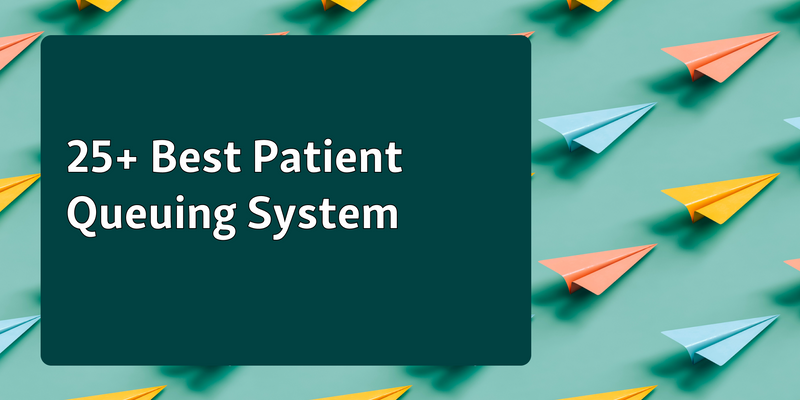Long lines don’t just waste time, they add stress for patients and staff. That’s where patient queuing software makes a real difference. It helps organize the flow, reduce confusion, and make visits feel smoother.
Whether you're managing a small clinic or a large hospital, a proper system keeps things moving.
In this blog, we’ll look at 20+ tools built to improve how clinics and hospitals handle check-ins and wait times.
TL;DR (Quick Comparison Table)
Choosing the right queue management system in hospital settings can be overwhelming. This quick comparison table breaks down 21 leading platforms by core capabilities, ease of use, and pricing transparency, helping you decide faster and smarter.
Platform | Patient Check-In Options | Standout Feature | Pricing Info |
Kiosk, phone, web, QR | Real-time notifications + queue dashboards | From $389/month | |
Vizitor | QR, OTP, tablet | Smart token management | From $36/month |
Qmatic | Web, kiosk | HL7 integration and priority routing | On request |
Qwaiting | Kiosk, mobile, web | WhatsApp/SMS alerts + multilingual UI | On request |
Qtrac | SMS, QR, kiosk | Greeter mode and re-routing | On request |
Wavetec | WhatsApp, web, kiosk | Post-visit feedback + signage integration | On request |
QLess | App, SMS, kiosk | Callback queue and two-way messaging | On request |
QueueTix | QR, location code | No hardware required | On request |
Qnomy | Kiosk, app, virtual lobby | Full journey + back-office integration | On request |
Nemo-Q | QR, kiosk, mobile | Real-time alerts + signage | From $290/month |
QueuePad | QR, tablet | Works offline + fast setup | From $19.99/month |
Awebstar | QR, kiosk | Centralized dashboards + SMS updates | On request |
Leyline | Kiosk, mobile | One-ticket patient tracking | From €80/month |
Earlyone | App, browser, widget | Predictive wait-time algorithm | On request |
Qmagic | Kiosk, web | Multi-screen display + control panel | On request |
Qtip | App, browser, kiosk | In-app feedback + offline mode | From €79/month |
Timeacle | App, web, kiosk, phone | Appointment-callup integration | From €49.90/month |
Qticket | Mobile, browser | App-free virtual queuing + Azure secure | On request |
VirtuaQ | Web, SMS, kiosk, mobile | Pooled multi-step routing + HIS integration | On request |
Engageware | Web, AI, mobile | Knowledge base + AI content tools | On request |
Verint | Mobile, kiosk, omnichannel | Enterprise workflow + analytics suite | On request |
Top 20+ Patient Queuing Tools
There’s no one-size-fits-all solution when it comes to managing queues in healthcare. Some tools are built for speed, others for scale. Here are 20+ tools built to reduce wait times, ease staff load, and improve patient flow.
1. Qminder
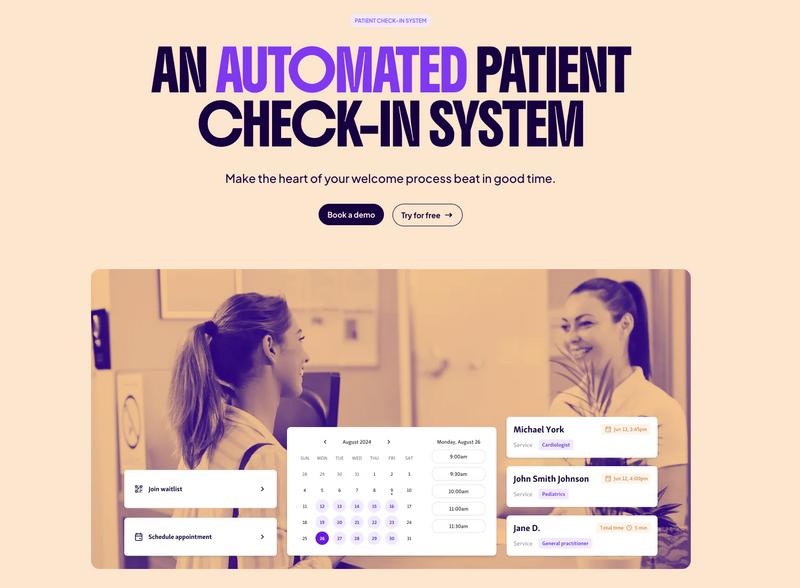
Qminder is a simple, HIPAA-compliant patient check-in system that doesn’t make the process feel like a hassle. It helps clinics and hospitals keep things moving without the crowding or confusion. Patients can check in through a kiosk, on their phones, or from a browser. Once they’re in line, they get real-time updates about their place in the queue.
Staff also get a clear view of how busy each location is. You can track wait times, see bottlenecks, and make better decisions around scheduling. It’s built to make life easier for both patients and staff, while keeping sensitive information protected.
Key Features:
Schedule and manage appointments in the same service dashboard as check-ins
Let patients check in from a kiosk, phone, or browser
Send real-time SMS or app alerts about their place in line
Manage queues across multiple clinic locations with one system
Track wait times, service times, and flow from check-in to checkout
Pull reports that show you what’s working and what’s not
Easily integrate it with your EHR (Electronic Health Record), CRM and scheduling software
Pros:
Clean and simple for both patients and staff
Good reporting to improve staff planning and speed
Works well for multi-location clinics
Cons:
Might feel too feature-heavy for small, single-provider clinics
Data security: HIPAA - ready, SOC 2 Type II, CCPA, GDPR / UK GDPR Annual network and application pen-test HIPAA BAAsm followed by AWS Well-Architected best practices CIS Benchmarks.
G2 Rating: 4.6
Pricing: Free 14-day trial. Paid plans start at $389/month.
2. Vizitor

Vizitor is a digital patient queuing software that helps hospitals manage check-ins without the clutter of paper forms or manual entries. Patients can register through a mobile phone, tablet, or browser using a QR code or OTP.
Once checked in, they receive real-time updates about their spot in line, reducing the need to crowd around the front desk. This queuing system in hospital settings allows staff to track live queue activity and direct patients to the right department automatically.
Key Features:
Digital check-in through tablet, phone, or QR code
Real-time queue updates sent via SMS or app
Smart token assignment across multiple departments
Nightly queue reset and token management
Dashboard to monitor patient flow and wait times
Works as a secure, cloud-based hospital queuing system
Pros:
Easy for patients and staff to use
Handles large volumes across different departments
Cons:
May need support for setup in larger hospitals
Custom branding features can be limited in lower plans
Data security: Encryption at rest/in transit, GDPR/CCPA/HIPAA-aligned practices, OTP/ID verification, digital audit logs, regular security audits (no public SOC 2 or HIPAA BAA).
G2 Rating: 4.1
Pricing: Starts at $36/month.
3. Qmatic

Qmatic is a patient queuing software built for complex healthcare environments that need advanced management tools. Patients can check in online or at kiosks using QR codes or links. They receive real-time updates via displays or mobile alerts.
This hospital queuing system handles both scheduled appointments and walk-ins. It also supports virtual queuing so patients can wait offsite.
Key Features:
Check-in via web or kiosk with virtual ticket generation
Real-time queue displays and mobile ticket updates
Priority routing for elderly or urgent cases
Dashboard and analytics on wait times and service flow
Integration with existing hospital information systems using HL7 middleware
Pros:
Supports multiple touchpoints from arrival to post-service feedback
Analytics help staff adjust workflows and reduce patient stress
Cons:
Requires technical setup for HL7 integration in larger hospitals
Admin interface can feel complex for non-technical staff
Data security: ISO 27001:2022-certified, encryption in transit & at rest, GDPR aligned, proactive monitoring/audits—no public SOC 2 or HIPAA BAA mention.
G2 Rating: 3.8
Pricing: Price available on request.
4. Qwaiting
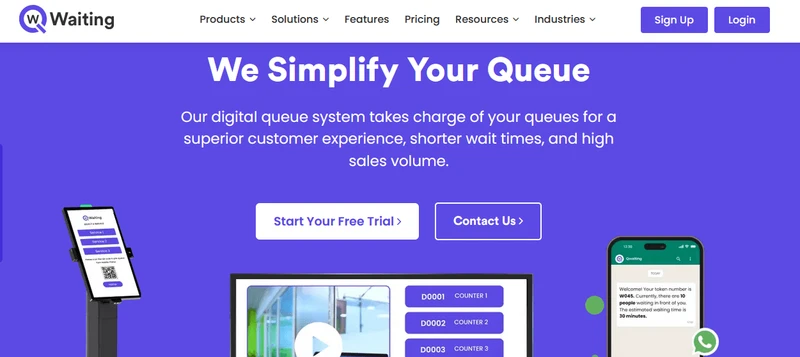
Qwaiting is a cloud-based patient queuing software widely used in Asia. It helps hospitals and clinics manage patient flow using kiosks, mobile, or web check-ins. Patients can join the queue remotely or onsite and receive real-time updates via SMS, WhatsApp, or email.
This hospital queuing system removes paper tokens and gives staff a clear picture of queue status. It handles token generation, staff keypad operations, and multilingual support.
Key Features:
Appointment booking and virtual queuing built in
Staff use keypads or desktops to call next patients
Custom displays and signage show queue info live
Multi-language support and branding options
Cloud-based access for multiple branches
Pros:
Very user-friendly interface for both patients and staff
Real-time reporting helps hospitals monitor and improve flow
Cons:
Limited customization in some pricing tiers
Mobile interface may feel slow or clunky in high-volume settings
Data security: Uses AWS with encryption at rest and in transit, strong access controls, GDPR-compliant privacy practices
G2 Rating: 4.7
Pricing: Price available on request.
5. Qtrac
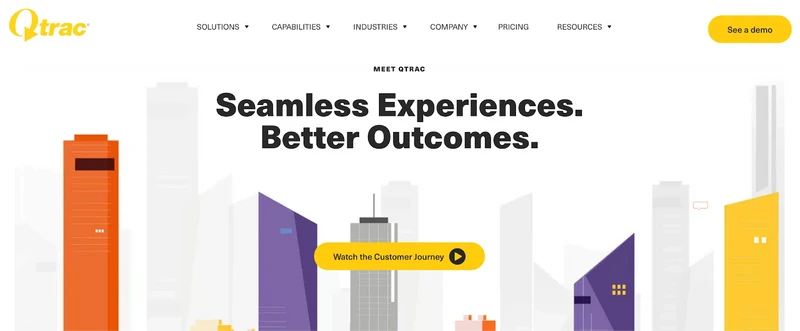
Qtrac is a patient queuing software designed for hospitals that need more control over complex patient flows. It supports virtual check-ins, walk-ins, and pre-scheduled appointments.
Patients can join the queue via SMS, QR code, or kiosk, and follow their status without waiting in crowded areas. This hospital queuing system is ideal for managing foot traffic across multiple departments.
Key Features:
Queue re-routing that lets staff move patients to another department without restarting the process
Real-time notifications triggered when wait times pass set thresholds
Greeter mode for front-desk staff to pre-screen and assign patients to services
Offline mode to keep queues moving during internet outages
Centralized dashboard for hospitals managing multiple entry points or buildings
Pros:
Supports complex hospital layouts with multiple touchpoints and departments
Allows front-desk staff to redirect patients instantly based on needs or availability
Cons:
Greeter-based check-in setup may require staff training
Offline functionality is basic and sync delays can happen once reconnected
Data security: SOC 2, HIPAA & GDPR-aligned with independent audits; encryption in transit & at rest; least-privilege access controls; regular penetration testing and vulnerability scans.
G2 Rating: 4.7
Pricing: Price available on request.
Read also - Are Walk-Ins More Efficient Than Appointments?
6. Wavetec

Wavetec delivers a robust patient queuing software that ties together appointment scheduling, queue management, and post-visit feedback. Designed for hospital settings, it combines kiosks, web booking, WhatsApp registration, and digital signage.
Patients can book in advance, check in digitally, and receive virtual tickets, all without crowding the reception area. This hospital queuing system ensures each step in the journey is tracked and organized.
Key Features:
WhatsApp-based appointment booking and check-in to boost engagement
Interactive digital signage that guides patients in real time
Post-visit feedback module to collect satisfaction data via SMS or WhatsApp
Self-service kiosks for billing, printing, or information retrieval
Feedback dashboards that highlight service gaps and patient pain points
Pros:
Enhances patient flow with conversational WhatsApp check-in and support
Combines queue control and feedback collection in one hospital queuing system
Cons:
Requires coordination for self-service kiosk deployment across departments
Feedback module adds layers of configuration, which may slow rollout
Data security: SOC 2 Type II, ISO 27001:2022, HIPAA compliant, GDPR aligned, with encryption in transit & at rest and proactive audits/monitoring.
G2 Rating: 4.8
Pricing: Price available on request.
7. QLess
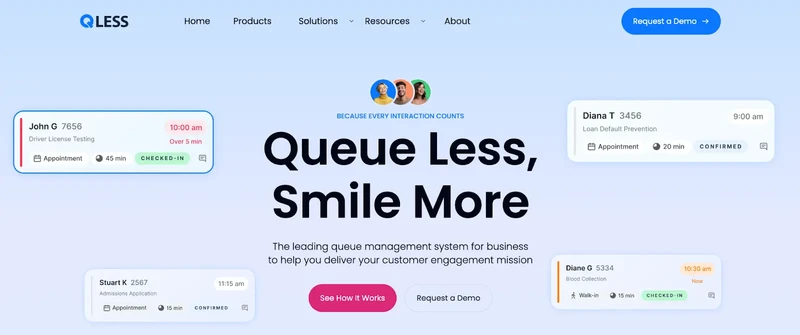
Qless is a patient queuing software trusted by U.S. healthcare providers and DMVs for its seamless appointment scheduling and smart communication tools. It offers a modern virtual waiting room experience for hospitals and clinics, letting patients join lines via mobile, app, or kiosk, and wait remotely instead of in packed lobbies .
Key Features:
Two‑way messaging between staff and patients for smoother communication
Callback queuing that lets patients wait at home and receive a callback when it's their turn
AI‑powered scheduling that estimates wait times and balances patient load across locations
Dynamic flow control that automatically closes queues near closing time
Virtual waiting room that lets patients see queue status and delay alerts via app or SMS
Pros:
Bi‑directional messaging helps reduce confusion and keeps patient flow moving smoothly
Virtual callbacks and predictive alerts help clinics cut no‑show rates and keep lobbies uncrowded
Cons:
Callback workflows may overload staff if not properly scheduled
Smaller clinics might find the AI-driven load balancing too much feature for their scale
Data security: High-grade encryption in transit/storage, strong privacy protections and access controls, GDPR-aligned.
G2 Rating: 4.3
Pricing: Price available on request.
8. QueueTix
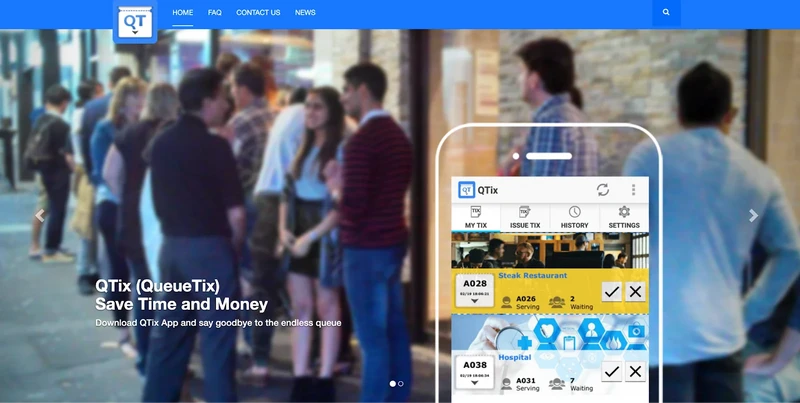
QueueTix is an app-based patient queuing software that replaces paper tokens and old-school ticket machines with a digital system. Patients check in using their phones or tablets by scanning a QR code or entering a location code.
Once in line, they can wait from anywhere and get alerts when it’s their turn. This hospital queuing system works well for clinics or departments looking for a lightweight, easy-to-use option.
Key Features:
Digital queue entry via QR code or location code
Real-time ticket updates with app or SMS alerts
Basic appointment booking through the same platform
Tablet-based setup with no extra hardware required
Live waitlist tracking with built-in messaging tools
Pros:
Quick to set up and easy to manage from a mobile device
Reduces physical congestion by allowing remote waiting
Cons:
Lacks advanced queue routing or staff performance tracking
Interface may feel dated compared to newer platforms
Data security: Standard privacy safeguards, encryption of cookies-related data for ad tracking, authorized access controls
Capterra Rating: 5.0
Pricing: Price available on request.
9. Qnomy
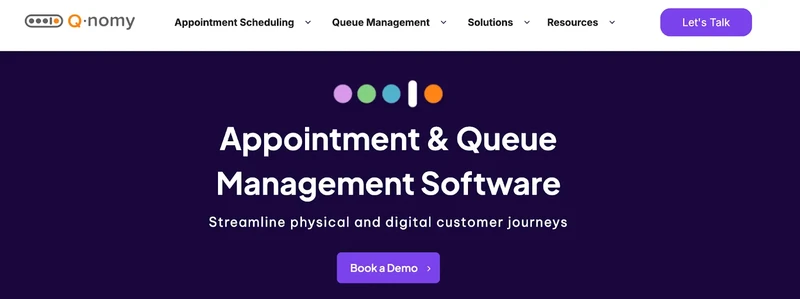
Qnomy is a patient queuing software built for hospitals that need more than just line management. It handles the entire patient journey, from booking an appointment to walking out the door.
Patients can check in through kiosks, mobile apps, or a virtual lobby. Staff can route them based on priority, service type, or available resources. This hospital queuing system is especially useful when different departments need to coordinate care.
Key Features:
Integrated patient flow with both front-office and back-office task management
Skill-based routing to assign patients to available or best-suited staff
Custom workflows that match hospital protocols and patient types
Multi-service appointment scheduling from one patient portal
Interaction tracking across channels, including kiosks, video calls, and chat
Pros:
Strong fit for hospitals that need to connect service counters with internal operations
Flexible workflows allow customization without heavy coding
Cons:
Some modules require setup time and support to align with existing systems
Interface can feel complex for teams used to simpler platforms
Data security: HIPAA & GDPR compliant (Q-Flow 6.4), with encrypted data handling
G2 Rating: 4.3
Pricing: Price available on request.
10. Nemo-Q
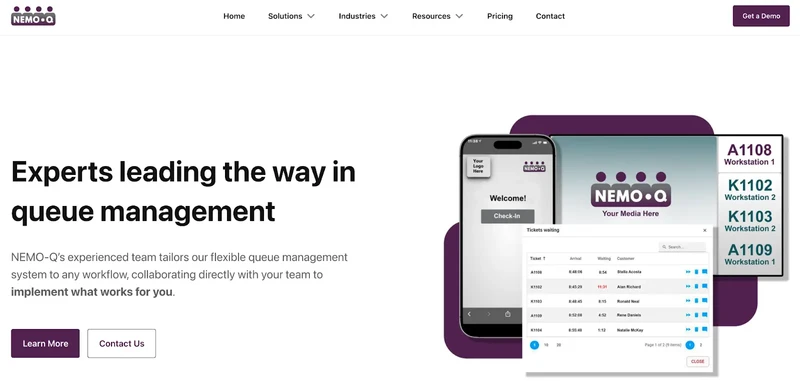
Nemo-Q is a patient queuing software that simplifies hospital visits with digital check-ins and real-time updates. Patients can join the line from their phone, a kiosk, or online. They receive alerts about their wait time and where to go next.
This hospital queuing system helps reduce crowded lobbies while keeping patients informed at every step. For staff, it gives a clear view of each queue and department load.
Key Features:
Patients can check in using QR codes, kiosks, or mobile links
Digital signage shows ticket numbers, wait time, and instructions
Real-time queue alerts and updates sent by SMS
Appointment scheduling blended with live queue activity
Built-in customer feedback tool to collect insights after each visit
Pros:
Great for hospitals wanting to combine virtual check-ins with in-person service
Flexible setup works across multiple entry points and departments
Cons:
May require staff training to manage both scheduled and walk-in flows
Custom digital signage features can take time to configure
Data security: Encryption in transit and at rest, role-based access controls, regular audits, HIPAA & GDPR aligned, ADA compliant.
G2 Rating: N/A
Pricing: Starts at $290/month.
11. QueuePad
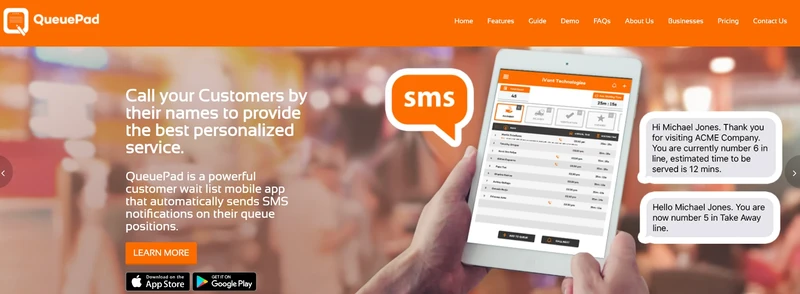
QueuePad is a simple patient queuing software built for smaller clinics and practices. It lets staff manage queues from a tablet or phone, and patients can join by scanning a QR code at the entrance.
There’s no need for an app download or even an internet connection for basic features. This hospital queuing system works best in settings where fast setup and ease of use matter more than advanced tech.
Key Features:
QR code check-in that works without downloading an app
Syncs with a tablet display so waiting patients see queue updates
SMS notifications when it’s time for the patient to be seen
Works offline for basic queuing if internet goes down
Lets staff re-call no-shows or call by name for a more personal feel
Pros:
Quick to set up and use, even without IT help
Good fit for single-provider clinics or small practices
Cons:
Lacks reporting depth or integration with hospital systems
Free version has limited queue and service options
Data security: SSL encryption in transit (via SSL secure server software), data encrypted at rest, strict access controls (password-protected servers), privacy-forward (no third-party sharing)
G2 Rating: 3.3
Pricing: Starts at $19.99/month.
12. Awebstar
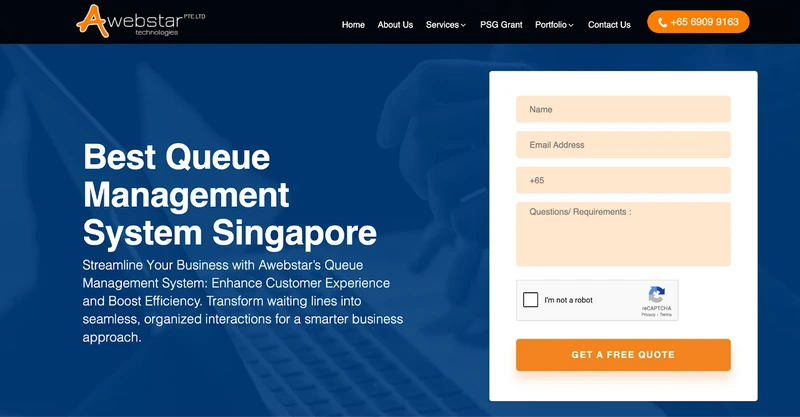
Awebstar’s patient queuing software is designed for hospitals that want to manage queues across multiple departments without confusing the patient or the staff. Patients can scan a QR code or walk up to a kiosk to check in.
The system sends SMS alerts and shows estimated wait times, helping people avoid crowding in waiting areas. This hospital queuing system handles scheduled appointments and walk-ins under one system.
Key Features:
QR-based check-in with SMS alerts and multilingual support
Cloud access to manage multiple branches and departments
Custom token screens with counter mapping and live updates
Feedback tools to gather patient satisfaction after service
Real-time reporting across staff, counters, and ticket volumes
Pros:
Works well for hospitals with multiple check-in points and service types
Supervisors get live visibility into queue data for better planning
Cons:
Setup may require training to manage advanced display and admin tools
Kiosk and signage hardware may be extra if not already owned
Data security: Advanced encryption and user authentication (e.g., SSL, secure login), robust data protection within CRM tools, and penetration testing/VAPT services available
G2 Rating: N/A
G2 Rating: 3.8
Pricing: Price available on request.
13. Leyline
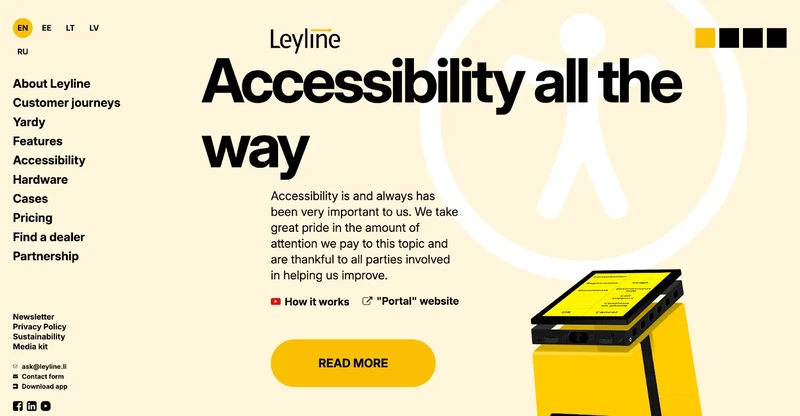
Leyline is a patient queuing software that keeps things simple without cutting corners. Patients can book appointments or enter the queue from their phone before they even walk in. Inside the hospital, branded kiosks greet them and guide them to the right service.
This hospital queuing system gives staff and patients clarity on where to go and when, making wait times less frustrating.
Key Features:
One-ticket system that tracks the full patient journey across departments
Cloud-based access with no local infrastructure needed
Kiosk and mobile check-in options with real-time updates
Custom alerts and reminders for patients during each step
Tailored dashboards and queue data for each location or service line
Pros:
Keeps queues organized even in complex, multi-service hospitals
Supports both physical and virtual queues from the same system
Cons:
Frequent system updates may require ongoing adjustments
Some advanced signage features can be tricky to cache or customize
Data security: Regularly updated EU-hosted cloud services with obfuscation of unneeded customer data, Linux-based secure hardware, geo-restricted network access, and optional VPN/IPSec tunneling
G2 Rating: 4.8
Pricing: Starts at €80/month.
14. Earlyone
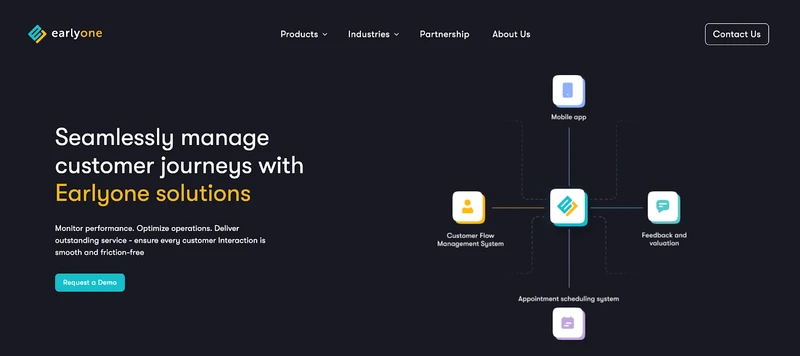
Earlyone is a patient queuing software that cuts down wait times with a combination of mobile bookings, queue forecasting, and real-time analytics. Patients can reserve a spot using the app, and the system tells them exactly when to arrive to avoid sitting around.
This makes it a strong hospital queuing system for clinics that want to balance walk-ins with scheduled visits.
Key Features:
Predictive wait-time algorithm that tells patients when to arrive
Unified dashboard with queue status, staff activity, and service feedback
Appointment and walk-in blending via app, widget, or browser
Custom real-time surveys to measure patient satisfaction
Lightweight installation—runs on cloud with no extra hardware needed
Pros:
Works well for clinics trying to reduce idle lobby time and no-shows
Mobile check-in and smart wait-time alerts improve patient flow
Cons:
Requires patient buy-in for app use to get full value
Some reports may need customization for local compliance standards
Data security: GDPR-aligned safeguards against unauthorized access and data misuse
G2 Rating: N/A
Pricing: Price available on request.
15. Qmagic
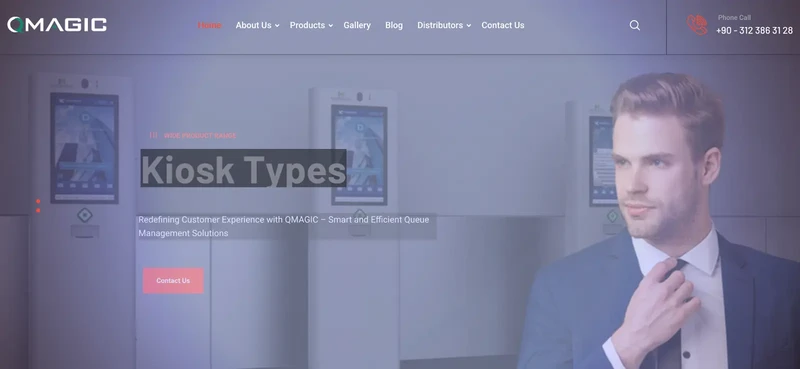
Qmagic is a patient queuing software built with a digital-first mindset. Hospitals can manage walk-ins, appointments, and service flow from one central platform. It works through self-service kiosks and display units that show real-time updates, making it easy for patients to understand where they stand and where to go next. The system is designed to feel smooth for everyone, patients, reception teams, and administrators.
Key Features:
Central control panel for patient check-ins, ticketing, and status updates
Multi-screen display for queues, service counters, and public announcements
Kiosk-based and online check-in with printed or digital tickets
Custom workflow settings for different departments and patient paths
Cloud-based reports and performance tracking across service units
Pros:
Strong visual tools that improve the in-hospital experience for patients
Flexible deployment works across departments or single-service counters
Cons:
Hardware like kiosks and displays are necessary for full functionality
May need configuration support to adapt the system to each hospital’s flow
Data security: No publicly published details found on encryption, audits, or certifications such as ISO, SOC 2, HIPAA, or GDPR.
G2 Rating: N/A
Pricing: Price available on request.
16. Qtip
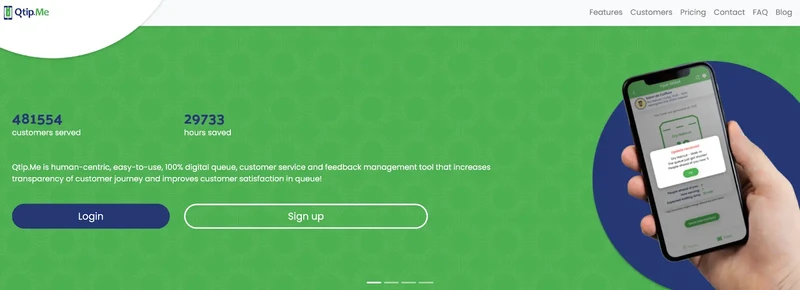
Qtip is a lightweight patient queuing software designed for smaller clinics that need to manage wait times without getting tangled in complexity. It lets patients join the queue from their phone, browser, or an in-clinic kiosk. Once they’re in line, they get real-time updates about their place and when to return, no more crowding the waiting room.
Key Features:
Patients can join queues remotely or at walk-in kiosks
Real-time SMS or app notifications as their turn approaches
In-app feedback for service quality right after check-out
Option to run on web browser or native app without installation hurdles
Works even without internet for basic queue tracking
Pros:
Great for smaller facilities looking for a clean, quick solution
Encourages social distancing with remote queue access
Cons:
Free version has limited ticketing and staff access
Not ideal for high-volume hospitals with multi-step service flow
Data security: No public information available.
G2 Rating: N/A
Pricing: Starts at €79/month..
17. Timeacle
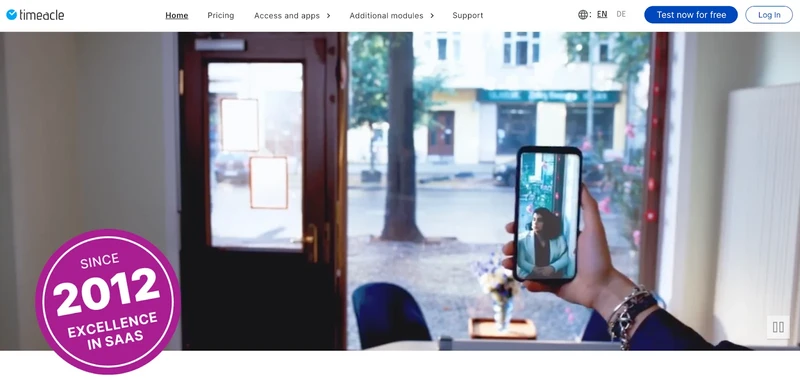
Timeacle is a flexible platform that combines appointment booking with queue call-ups. It’s designed to help clinics and hospitals manage both scheduled visits and walk-ins without crowding. Patients can check in online, by phone, or at a kiosk and get updates on their status. It’s a solid fit for any hospital looking to keep the flow smooth and the waiting room clear.
Key Features:
Combine bookings and ticketing into one easy system
Let patients join via app, web, phone, or kiosk
Guide patients through multi-department visits with one ticket
Show live wait times and ticket updates on displays
Pull real-time reports to spot bottlenecks and delays
Pros:
Handles appointments and walk-ins without overlap
Smooth patient flow across departments with fewer delays
Cons:
Works best when patients use the app or online tools
Setup can take time if your hospital has many departments
Data security: GDPR-compliant with robust security practices (encryption, access controls, transparent data handling)
G2 Rating: N/A
Pricing: Starts at €49.90/month.
18. Qticket
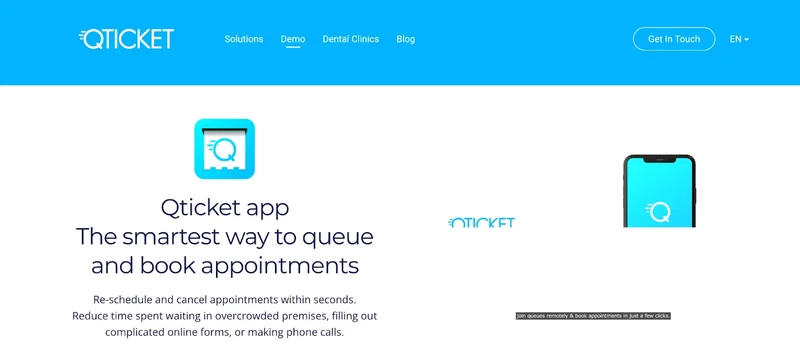
Qticket is a user-focused virtual queuing system that modernizes check-ins and appointment scheduling entirely via mobile or browser. Without needing new hardware or training, hospitals can let patients join lines remotely and receive updates in real time. It’s a clean and efficient queue management system in hospital settings, especially when simplicity matters more than deep functionality.
Key Features:
Remote queue joining and appointment booking via smart device
No new infrastructure needed, leverages existing tools
Secure cloud-based platform built on Azure
Virtual queuing and booking can be used together or separately
Real-time updates visible to staff and patients with minimal UI
Pros:
Extremely easy to deploy and use without hardware upgrades
Secure, cloud-based system with remote access convenience
Cons:
Limited routing, analytics, or multi-department tracking
Best suited for simpler service flows, not full hospital operations
Data security: GDPR-compliant with comprehensive data protection policies, user authentication, and cybersecurity best practices
G2 Rating: 5
Pricing: Price available on request.
19. VirtuaQ
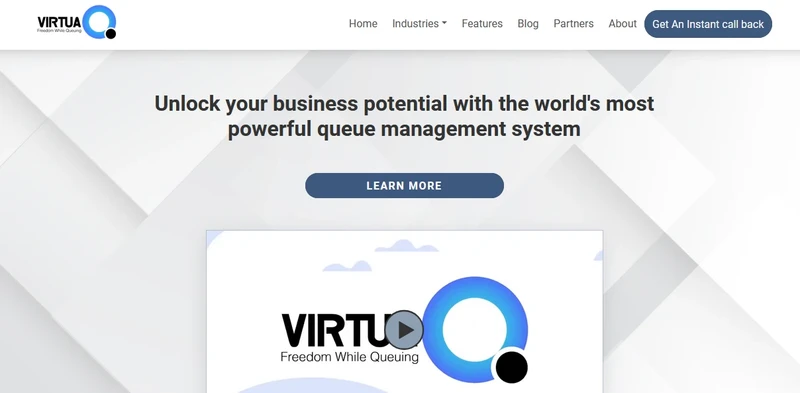
VirtuaQ is a feature-rich queue management system in hospital environments built for scalability and seamless digital integration. It lets patients join queues remotely via web, SMS, kiosks, or mobile devices and receive real-time token updates. As a queuing system in hospital settings, it minimizes lobby crowding and speeds up patient processing through dynamic routing and priority handling.
Key Features:
Virtual queue joining via kiosk, web, SMS, or mobile
Dynamic pooled queues for efficient multi-step patient flow
Priority and VIP routing support
Real-time dashboards and heatmap analytics per clinic
Integration with existing HIS, kiosks, and digital signage
Pros:
Greatly reduces wait time and operational friction in hospital wards
Hardware-agnostic and integrates easily with legacy hospital systems
Cons:
Advanced configuration may require vendor support early on
Data security: No public information available.
G2 Rating: 4.8
Pricing: Price available on request.
20. Engageware
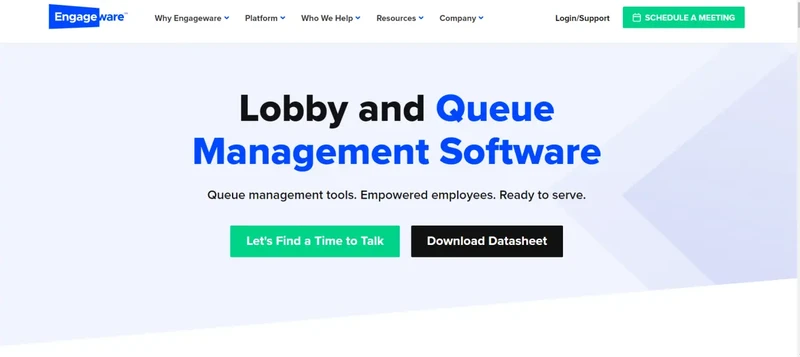
Engageware offers a versatile, AI-enhanced queue management system in hospital settings that need more than just ticketing. It blends virtual queuing with appointment scheduling, customer self-service, and a robust knowledge base, helping hospitals streamline patient check-ins and staff coordination.
Key Features:
Unified queuing and appointment scheduling
AI-assisted knowledge base for staff
Multichannel patient interactions and notifications
Real-time content feedback and management tools
24/7 customer self-service options
Pros:
Smart content integration boosts frontline staff efficiency
Works well across hospital departments for appointments and internal protocols
Cons:
Interface can be complex for less tech-savvy teams
Limited customization of user roles and dashboard views
Data security: ISO 27001 & ISO 9000 certified solutions with GDPR compliance, robust privacy practices, and a responsible-disclosure vulnerability policy
G2 Rating: 4.4
Pricing: Price available on request.
21. Verint
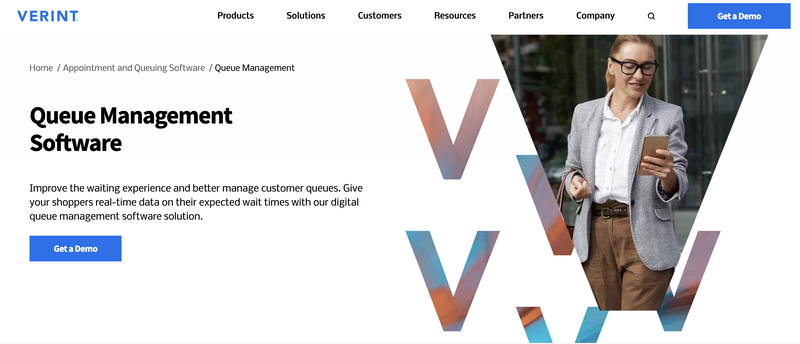
Verint’s Appointment and Queuing Software, powered by Qudini, is an enterprise-grade queue management system in hospital and retail settings. It merges appointment scheduling with smart queue flow management to streamline operations, reduce walkouts, and drive better in-person experiences.
Key Features:
Smart appointment and queue integration
Event and task management
Real-time queue notifications
Interactive kiosk and mobile queue access
Omnichannel synchronization
Pros:
Reduces patient walkouts and boosts service flow
Easy to scale across hospital departments or locations
Cons:
Dashboard and interface may feel complex at first
Higher upfront cost for small to midsize hospitals
Data security: SOC 2, ISO 27001, PCI-DSS, HIPAA-compatible; AES-256 encryption, audits, and 24/7 monitoring.
G2 Rating: 4.3
Pricing: Price available on request.
Also Read - 32 Best Virtual Queue Systems – Free & Paid
Choosing the Right Queue Management System For Hospitals
Managing queues in a hospital isn’t just about speed, it’s about reducing stress, improving care, and giving patients control over their time. From advanced routing to mobile check-ins and real-time updates, the right system can transform how your clinic or hospital operates. Each platform here has strengths, whether you run a small practice or a complex healthcare facility.
If you're looking for a hospital queuing system that’s reliable, intuitive, and built for both patients and staff, Qminder is an ideal choice.
Start your free trial with Qminder today.
Yes, many queuing systems now avoid calling out patient names or displaying personal information publicly. Instead, they use ticket numbers, private SMS notifications, or secure app updates, ensuring patients are discreetly informed while waiting.
Not at all. While larger hospitals benefit from advanced features like department routing and analytics, smaller clinics gain just as much from simplified check-ins and reduced lobby congestion. Even a single-provider clinic can enhance patient flow and satisfaction with a lightweight system.
Most modern queue management solutions are designed to be plug-and-play. Many run entirely in the cloud and only need a tablet, smartphone, or browser to operate. You don’t need a full IT team or expensive hardware to get started, especially with platforms like Qminder.

